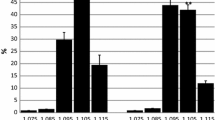Abstract
Eight healthy untrained male volunteers pedalled a cycle ergometer according to two exercise protocols: the first involved step-wise increasing physical exercise to maximal (MPE); the second involved prolonged (35 min) submaximal physical exercise (PPE) at 70% of the individual's maximal oxygen uptake. Each volunteer performed these exercise twice, following either an intravenous injection of phosphocreatine (PCr) or a placebo of an isotonic NaCl solution. Anaerobic threshold (AT) was determined from the point of departure of the ventilatory response from linearity and from the sudden increase in venous blood lactate concentrations during MPE. After exercise following placebo administration we observed increases in concentrations of blood substrates, plasma adrenocorticotropin (ACTH), growth hormone and cortisol and in the number of glucocorticoid receptors in lymphocytes without changes in the dissociation constant. Intravenous administration of PCr (starting 1 day before exercise) led to an increase in the total workload (on average by 5.8%) and in AT (on average by 6.8%) during MPE and to a better tolerance of exercise during PPE. Following PCr administration we observed lower blood lactate concentrations and different patterns of some enzyme activities, less pronounced changes in plasma ACTH and cortisol concentrations and in glucocorticoid binding in lymphocytes, but no changes in plasma growth hormone concentrations compared to the placebo. The results showed that intense physical exercise led not only to increases in blood hormone concentrations but also to an increase in the density of glucocorticoid receptors in lymphocytes. Intravenous PCr injection led to smaller changes in ACTH and cortisol concentrations as well as to a lower activation of glucocorticoid binding in lymphocytes.
Similar content being viewed by others
References
Adams GR, Foley JM, Meyer RA (1990) Muscle buffer capacity estimated from pH changes during rest-to-work transitions. J Appl Physiol 69: 968–972
Balsom PD, Ekblom B, Soderlund K, Sjodin B, Hultman E (1993) Creatine supplementation and dynamic high-intensity intermittent exercise. Scand J Med Sci Sport 3: 143–149
Bronnegard M, Werner S, Gustafsson JA (1986) Primary cortisol resistance associated with a thermolabile glucocorticoid receptor in a patient with fatigue as the only symptom. J Clin Invest 78: 1270–1278
Cashmore GC, Davies CTM, Few JD (1977) Relationship between increases in plasma cortisol concentration and rates of cortisol secretion during exercise in man. J Endocrinol 72: 109–110
Cheetham ME, Boobis LH, Brooks S, Williams C (1986) Human muscle metabolism during sprint running. J Appl Physiol 61: 54–60
Chrousas GP, Loriaux DL, Brandon D, Vingerhoeds ACM, Lipsett MB (1983) Primary cortisol resistance: a familial syndrome and an animal model. J Steroid Biochem 19: 567–575
Chwalbinska-Moneta J, Robergs RA, Costill DL, Fink W (1989) Threshold for muscle lactate accumulation during progressive exercise. J Appl Physiol 66: 2710–2716
Czerwinski SM, Hickson RC (1990) Glucocorticoid receptor activation during exercise in muscle. J Appl Physiol 68: 1615–1620
Farrell PA, Garthwaite TL, Gustafson AB (1983) Plasma adrenocorticotropin and cortisol responses to submaximal and exhaustive exercise. J Appl Physiol 55: 1441–1444
Galbo H (1986) The hormonal response to exercise. Diabetes Metab Rev 4: 385–408
Greenhaff PL, Bodin K, Harris RC, Hultman E, Jones DA, McIntyre DB, Soderlund K, Turner DL (1993a) The influence of oral creatine supplementation on muscle phosphocreatine resynthesis following muscle contraction in man. J Physiol 467: 75 p
Greenhaff PL, Casey A, Short AH, Harris RC, Soderlund K, Hultman E (1993b) Influence of oral creatine supplementation on muscle torque during repeated bouts of maximal voluntary exercise in man. Clin Sci 84: 565–571
Harris RC, Soderlund K, Hultman E (1992) Elevation of creatine in resting and exercised muscle of normal subjects by creatine supplementation. Clin Sci 83: 367–374
Kjaer M, Secher NH, Bach FW, Galbo H (1987) Role of motor center activity for hormonal changes and substrate mobilization in humans. Am J Physiol 253: R687-R695
Kjaer M, Secher NH, Bach FW, Sheikh S, Galbo H (1989) Hormonal and metabolic responses to exercise in humans: effect of sensory nervous blockade. Am J Physiol 257: E95-E101
Korge P, Medianinen L (1986) The effect of isoprenalin and physical exertion to exhaustion on the mechanism of glucocorticoid action in the rat heart. J Mol Cell Cardiol 48: 557–566
Kraemer WJ, Patton JF, Knuttgen HG, Marchitelli LJ, Cruthirds C, Damokosh A, Harman E, Frykman P, Dziados JE (1989) Hypothalamic-pituitary-adrenal responses to short-duration high-intensity cycle exercise. J Appl Physiol 66: 161–166
Meirlier KD, Naaktgeboren N, Steirteghem AV, Gorus F, Olbrecht J, Block P (1986) Beta-endorphin and ACTH levels in peripheral blood during and after aerobic and anaerobic exercise. Eur J Appl Physiol 55: 5–8
Pratt WB (1990) Glucocorticoid receptor structure and the initial events in signal transduction. Prog Clin Biol Res 322: 119–132
Robinson LA, Brambrige MV, Hearse DJ (1984) Creatine phosphate: an additive myocardial protective and antiarrhythmic agent in cardioplegia. J Thorac Cardiovasc Surg 87: 190–200
Saks VA, Strumia E (1993) Phosphocreatine — molecular and cellular aspects of the mechanism of cardioprotective action. Curr Ther Res 53: 565–598
Schlechte JA, Ginsberg BN, Sherman BM (1982) Regulation of the glucocorticoid receptor in human lymphocytes. J Steriod Biochem 16: 69–74
Spriet LL, Söderlund K, Bergström M, Hultman E (1987) Anaerobic energy release in skeletal muscle during electrical stimulation in men. J Appl Physiol 62: 611–615
Systrom DM, Kanarek DJ, Kohler SJ, Kazemi H (1990)31P nuclear magnetic resonance spectroscopy study of the anaerobic threshold in humans. J Appl Physiol 68: 2060–2066
Tabata I, Atomi Y, Mitsumasa M (1984) Blood glucose concentration dependent ACTH and cortisol responses to prolonged exercise. Clin Physiol 4: 299–307
Völlestad NK, Sejersted OM (1988) Biochemical correlates of fatigue. Eur J Appl Physiol 57: 336–347
Yamamoto Y, Miyashita M, Hughson R, Tamura S, Shinohara M, Mutoh Y (1991) The ventilatory threshold gives maximal lactate steady state. Eur J Appl Physiol 63: 55–59
Author information
Authors and Affiliations
Rights and permissions
About this article
Cite this article
Vorobiev, D.V., Vetrova, E.G., Larina, I.M. et al. Energy substrates, hormone responses and glucocorticoid binding in lymphocytes during intense physical exercise in humans following phosphocreatine administration. Europ. J. Appl. Physiol. 74, 534–540 (1996). https://doi.org/10.1007/BF02376769
Accepted:
Issue Date:
DOI: https://doi.org/10.1007/BF02376769




